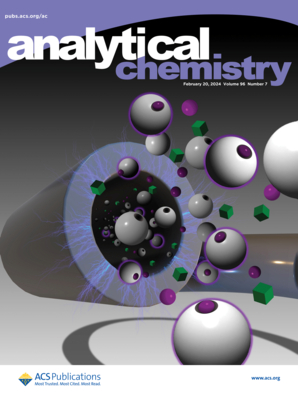Mutually Activated Dual-Exponential Amplification DNA Machine Enhances Robust CRISPR/Cas12a Feedback Propagation for Ultrasensitive miRNA Detection
IF 6.7
1区 化学
Q1 CHEMISTRY, ANALYTICAL
引用次数: 0
Abstract
Breast cancer (BC) remains a critical global health challenge, necessitating ultrasensitive methods for detecting biomarkers such as miR-155, a key regulator in BC progression. Here, we present a mutually activated dual-exponential amplification DNA machine (MADEA-DNA machine) for ultrasensitive miR-155 detection. This system integrates exponential rolling circle amplification (E-RCA) and autocatalytic incremental strand displacement amplification (AI-SDA), driven by a bidirectional activation mechanism. Target miR-155 initiates E-RCA via a functional primer probe (FPP) or AI-SDA through a functional hairpin probe (FHP), with amplification products cross-activating the counterpart system to establish a self-reinforcing loop. The resultant amplicons further activate CRISPR/Cas12a, enabling the trans-cleavage of fluorescent reporters for signal amplification. The MADEA-DNA machine achieves a detection limit of 1.26 fM, with a dynamic range spanning 5 fM–10 nM, and demonstrates exceptional specificity against mismatched and nontarget miRNAs. Validation in human serum revealed significantly elevated miR-155 levels in BC patients versus healthy donors, corroborated by qRT-PCR. This system combines machine-like operational efficiency, dual-amplification synergy, and CRISPR-enhanced sensitivity, offering a robust platform for liquid biopsy applications in early BC diagnostics.

互激活双指数扩增DNA机增强CRISPR/Cas12a反馈传播用于超灵敏miRNA检测
乳腺癌(BC)仍然是一个关键的全球健康挑战,需要超灵敏的方法来检测生物标志物,如miR-155,这是BC进展的关键调节因子。在这里,我们提出了一种相互激活的双指数扩增DNA机(MADEA-DNA机),用于超灵敏的miR-155检测。该系统集成了指数滚动循环扩增(E-RCA)和自催化增量链位移扩增(AI-SDA),由双向激活机制驱动。靶miR-155通过功能性引物探针(FPP)启动E-RCA,或通过功能性发夹探针(FHP)启动AI-SDA,扩增产物交叉激活对应系统,建立自我强化回路。由此产生的扩增子进一步激活CRISPR/Cas12a,使荧光报告基因能够进行反式切割以进行信号扩增。MADEA-DNA机器的检测限为1.26 fM,动态范围为5 fM - 10 nM,对错配和非靶标mirna具有特殊的特异性。在人血清中的验证显示,与健康供者相比,BC患者的miR-155水平显著升高,qRT-PCR证实了这一点。该系统结合了类似机器的操作效率、双扩增协同作用和crispr增强的灵敏度,为早期BC诊断中的液体活检应用提供了一个强大的平台。
本文章由计算机程序翻译,如有差异,请以英文原文为准。
求助全文
约1分钟内获得全文
求助全文
来源期刊

Analytical Chemistry
化学-分析化学
CiteScore
12.10
自引率
12.20%
发文量
1949
审稿时长
1.4 months
期刊介绍:
Analytical Chemistry, a peer-reviewed research journal, focuses on disseminating new and original knowledge across all branches of analytical chemistry. Fundamental articles may explore general principles of chemical measurement science and need not directly address existing or potential analytical methodology. They can be entirely theoretical or report experimental results. Contributions may cover various phases of analytical operations, including sampling, bioanalysis, electrochemistry, mass spectrometry, microscale and nanoscale systems, environmental analysis, separations, spectroscopy, chemical reactions and selectivity, instrumentation, imaging, surface analysis, and data processing. Papers discussing known analytical methods should present a significant, original application of the method, a notable improvement, or results on an important analyte.
 求助内容:
求助内容: 应助结果提醒方式:
应助结果提醒方式:


